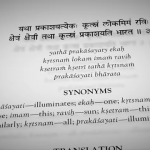Embarking on a Journey Through Bhagavad Gita’s Stories: Unveiling Spiritual Wisdom – Step into the profound world of the Bhagavad Gita, where timeless stories and parables paint a vibrant picture of self-discovery and divine connection. This sacred text, nestled within the epic Mahabharata, weaves a dialogue between Prince Arjuna and Lord Krishna on the battlefield of Kurukshetra. Beyond its historical roots, the Bhagavad Gita’s verses offer universal wisdom, accompanied by captivating parables that bring its teachings to life.

As we navigate through its chapters, we encounter not just philosophical insights but also relatable stories that encapsulate the core principles of duty, devotion, and the eternal nature of the soul. Join us on this exploration as we unfold metaphors such as the analogy of the Tortoise, the Cosmic Form of the Lord, the Chariot Analogy, and the Art of Detached Action, illustrating the transformative power of surrender.
Come along on this spiritual journey, where the stories within the Bhagavad Gita act as beacons of wisdom, lighting the way to self-discovery and inner transformation.
Table of Contents
1. The Prelude to Kurukshetra (Chapter 1):
The Bhagavad Gita commences with the scene on the battlefield of Kurukshetra, where Prince Arjuna is engulfed by doubt and moral dilemma. This sets the stage for Lord Krishna to impart spiritual wisdom.
2. Duty and Detachment (Chapter 2: Verse 47):
In the second chapter, the essence of duty and detachment is revealed. Arjuna is encouraged to perform his duty as a warrior without attachment to success or failure, drawing parallels to a soldier fulfilling responsibilities on the battlefield.
3. The Yoga of Devotion (Chapter 9: Verse 22):
As the teachings progress, the significance of devotional service is emphasized. Devotion to God is presented as a transformative force that transcends material desires, leading to spiritual fulfillment.
4. The Analogy of the Banyan Tree (Chapter 15: Verse 1-4):
The material world is analogized to an inverted banyan tree, urging individuals to cultivate detachment from material desires. This chapter encourages attachment to the spiritual realm, drawing wisdom from the symbolism of the ancient tree.
5. The Chariot Analogy (Chapter 3: Verse 5-9):
Describing the body as a chariot, the soul as the passenger, and the mind as the reins, the importance of controlling the mind is highlighted. This analogy underscores the significance of navigating life’s journey with a well-directed mind.
6. The Peace Formula (Chapter 5: Verse 29-32):
The principles of attaining peace through selfless action and devotion are outlined in this chapter. Acting in harmony with the divine will is presented as a key to inner tranquility and spiritual fulfillment.
7. The Three Modes of Material Nature (Chapter 14: Verses 5-18):
Describing the three gunas (modes) – goodness, passion, and ignorance – influencing human behavior, this chapter encourages individuals to rise above these modes through spiritual practices. It sheds light on the dynamics shaping our actions.
8. The Unbreakable Bonds of Love (Chapter 9: Verse 22):
The unbreakable bond of love between the devotee and the Supreme is discussed, illustrating the reciprocation of love between the soul and God. This chapter deepens the understanding of the profound connection that exists beyond material attachments.
9. The Art of Detached Action (Chapter 3: Verse 19-24):
The importance of performing one’s duties with a sense of detachment is taught in this chapter. By offering the results to the Divine, individuals can remain unaffected by success or failure, cultivating a mindset of detached action.
10. The Cosmic Form of the Lord (Chapter 11: Verses 7-9):
Describing the universal form of the Supreme, this chapter unveils the cosmic dimensions of God. The awe-inspiring nature of the Divine and the interconnectedness of all living beings are conveyed through this revelation.
11. The Essence of Surrender (Chapter 18: Verses 65-66):
The Bhagavad Gita concludes with an emphasis on complete surrender to the will of the Divine as the ultimate path to liberation. The significance of faith and devotion is stressed in achieving spiritual fulfillment.
12. The Story of Arjuna’s Dilemma (Chapter 1):
The Bhagavad Gita opens with Arjuna facing a moral dilemma on the battlefield of Kurukshetra. This story sets the tone for the entire scripture, portraying the internal struggles and challenges we encounter in our own lives.
13. The Science of Self-Realization (Chapter 2: Verse 12-30):
Expanding on the nature of the self, this chapter delves into the science of self-realization. It parallels the reflection of oneself in a mirror, emphasizing the importance of understanding our true nature for spiritual growth.
14. The Concept of Karma Yoga (Chapter 3):
The principles of Karma Yoga, emphasizing selfless action, are explored in this chapter. Like selfless worker contributing to a collective goal, individuals are encouraged to act without attachment to personal gains, fostering responsibility for the greater good.
15. The Vision of the Universal Form (Chapter 11):
The revelation of Lord Krishna’s universal form to Arjuna marks a pivotal moment. This vision underscores the vastness of divinity and the interconnected nature of all existence, providing a profound spiritual experience.
16. The Tale of Two Paths (Chapter 16: Verses 1-3):
This chapter presents a stark contrast between divine and demonic qualities, portraying them as two distinct paths. Similar to a traveler choosing between diverging roads, individuals are urged to make conscious choices aligning with virtuous qualities for spiritual progress.
17. The Symbolism of Sacrifice (Chapter 4: Verse 24):
Metaphorically using the concept of sacrifice, this chapter conveys spiritual wisdom. Just as rain benefits all plants, selfless acts of sacrifice are portrayed as beneficial not only for oneself but also for the world, fostering a harmonious existence.
18. The Analogy of the Tortoise (Chapter 5: Verse 29):
Drawing inspiration from the analogy of a tortoise withdrawing its limbs, this chapter underscores the importance of withdrawing the senses from external distractions. This withdrawal allows for introspection and spiritual focus, akin to the tortoise withdrawing into its shell for protection.
In this continued exploration of the Bhagavad Gita, each chapter unfolds a unique facet of spiritual wisdom, guiding individuals on a transformative journey toward self-realization and connection with the divine.





